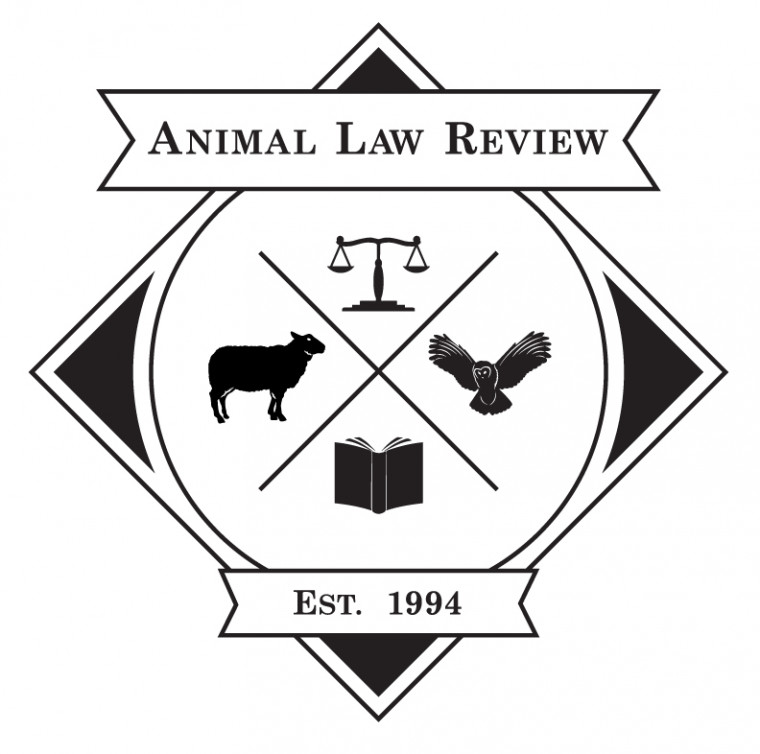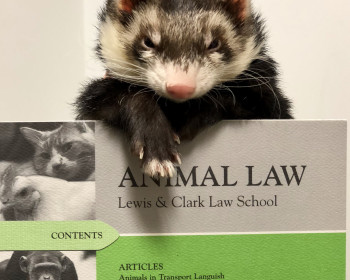Animal Law 24.1 Release
Open gallery

The Animal Law Review is pleased to announce the publication of Animal Law, Volume 24, Issue 1!
To get your copy visit: https://law.lclark.edu/law_reviews/animal_law_review/subscribe/
Symposium
Ani B. Satz ANIMALS AS LIVING ACCOMMODATIONS
This is the first symposium published in a law journal about using non-human animals as “living accommodations” for individuals with disabilities. The symposium features the work of both invited participants and speakers chosen from a call for papers issued by The Association of American Law Schools’ (AALS) Section on Animal Law for the AALS 2017 Annual Meeting, which was held in San Francisco, California, in January 2017. This program was co-sponsored by the Sections on Disability Law and Law and Mental Disability.
Laura Rothstein PUPPIES, PONIES, PIGS, AND PARROTS: POLICIES, PRACTICES, AND PROCEDURES IN PUBS, PADS, PLANES, AND PROFESSIONS: WHERE WE LIVE, WORK, AND PLAY, AND HOW WE GET THERE: ANIMAL ACCOMMODATIONS IN PUBLIC PLACES, HOUSING, EMPLOYMENT, AND TRANSPORTATION
This Article addresses how disability discrimination policy clarifies when animals might be allowed as accommodations in various settings. It provides the basic statutory and regulatory framework for these settings, additional administrative agency guidance, and some judicial interpretations of these requirements in various settings. Major settings where animals might be an accommodation are addressed separately, with particular focus on (1) higher education institutions because those settings have the potential of incorporating several different types of settings and (2) health care settings because of the particular concerns about health and safety.
Mackenzie Landa FROM WAR DOGS TO SERVICE DOGS: THE RETIREMENT AND ADOPTION OF MILITARY WORKING DOGS
Military Working Dogs (MWD) are canine service members that provide safety, comfort, love, and sometimes their lives to their human teammates. Soldiers rely on these dogs for companionship, support, and protection. However, handler dog teams are often separated when human soldiers return home from deployment. The dogs, classified as property by the Department of Defense, remain overseas and work until they are no longer useful to the military. Once the military decides a MWD is unable to serve, the dog is often left abroad unless a handler or nonprofit organization can fund the dog’s transport back to the United States.
This separation is damaging to both human and canine. When human soldiers returning home from war are unable to remain with their MWD partner, it takes a toll on their health and emotional well-being. Moreover, leaving dogs overseas is an injustice to the dogs who involuntarily serve their country with bravery and loyalty. Although lawmakers have achieved some legislative success to ensure that MWDs are no longer left behind and handlers are given the opportunity to adopt their dogs, there are gaps in the policy and there has been a significant failure to properly implement the legislation. This paper argues that it is necessary to amend military policy to ensure that dog and handler teams remain intact and each handler is given the opportunity to adopt his or her MWD.
Rebecca J. Huss CANINES IN THE CLASSROOM: ISSUES RELATING TO
SERVICE ANIMALS IN PRIMARY AND SECONDARY EDUCATIONAL INSTITUTIONS AFTER FRY V. NAPOLEON COMMUNITY SCHOOLS
The Supreme Court’s decision in Fry v. Napoleon Community Schools in February 2017 provides important guidance for advocates for students with disabilities partnered with service animals and school districts, however, areas of potential conflict remain. This Article reviews that Supreme Court decision and analyzes other recent cases to illustrate some of the complicated issues that may arise when students with disabilities want to be accompanied by their service animals in schools.
Paul Harpur, Simon Bronitt, Peter Billings, Martie-Louise Verreynne, & Nancy A. Pachana REGULATING ‘FAKE’ ASSISTANCE ANIMALS—A COMPARATIVE REVIEW OF DISABILITY LAW IN AUSTRALIA AND THE UNITED STATES
The current regulatory framework surrounding assistance animals is inadequate in both American and Australian law. The uncertainty it creates raises practical barriers to access for disabled people who rely on service animals. This article compares the respective shortcomings of each systems’ controls for service animals and recommends a direct system of regulation for the certification of service animals.
Articles
Ariel L. Bendor & Hadar Dancig-Rosenberg ANIMAL RIGHTS IN THE SHADOW OF THE CONSTITUTION
In this Article, we consider whether granting constitutional protections can improve animal welfare. To that end, we carry out a comparative analysis of legal systems that protect animal rights by constitutional tools, identify and analyze the ideas underlying those protections, and explore their adaptability. Focusing mainly on the Israeli case, we argue that constitutional law cannot provide adequate protections for animals and, contrary to the conventional wisdom, might even impair their protection.
Bruce Friedrich RITUAL SLAUGHTER, FEDERAL PREEMPTION, AND PROTECTION FOR POULTRY: WHAT LEGISLATIVE HISTORY TELLS US ABOUT USDA ENFORCEMENT OF THE HUMANE SLAUGHTER ACT
The one federal law that protects animals raised for food (farm animals) is the Humane Methods of Slaughter Act (HMSA), which, as its name implies, covers only the final moments of animals’ lives. Beyond overall lax enforcement, the United States Department of Agriculture (USDA) has made three interpretive decisions, one with support from the Supreme Court, that have further harmed farm animals: First, USDA exempt the ritual slaughter process from oversight. Second, USDA has thus far refused to protect poultry, who represent more than 98% of slaughtered land animals. And third, USDA has argued, and the Supreme Court agreed, that the HMSA preempts state laws that would offer greater protection than USDA chooses to offer under the law.
In Part II of this Article, I discuss the importance of farm animal protection and offer a brief introduction to the Humane Slaughter laws that exist in the United States. In Part III, I discuss the legislative history of humane slaughter statutory protection. And in Part IV, I consider whether USDA’s enforcement decisions with regard to ritual slaughter, poultry slaughter, and federal preemption of state law – which were backed by the Supreme Court – are supported by legislative history. I conclude that: (1) USDA’s refusal to regulate ritual slaughter in the ‘ritual bubble’ cannot be reconciled with legislative intent, as documented in the legislative history; (2) the Supreme Court’s decision in National Meat, which told states that they cannot grant greater slaughterhouse protection to animals than is offered by USDA regulations, was neither contemplated by, nor the intent of, Congress when it incorporated humane slaughter into the Federal Meat Inspection Act (FMIA); and (3) although the district court was wrong to hold that HMSA 1958 intended to exclude poultry, such a decision by USDA is within its discretion, according to the legislative history.
Richard Jochelson & James Gacek ‘RUFF’ JUSTICE: CANINE CASES AND JUDICIAL LAW MAKING AS AN INSTRUMENT OF CHANGE
The regulation of animals in North America should be apprised of evolving socialities. As the judiciary encounters situations of contestation between humans and animals in adjudication, it should take notice of the emergence of animal recognition in Western societies. Law is apprised of sociality, can absorb social
information, and may, at times, reflect how citizens view issues of justice. What was once innocent behavior can be reconstituted as criminal through the adjudicative exercise (and vice-versa). In this Paper, we investigate socio-legal constructions of ‘the animal’ in two recent North American adjudications. In two
recent cases, R. v. D.L.W. and State v. Newcomb, the Supreme Court of Canada and the Oregon Supreme Court contested what it means to be an animal in situations of bestiality and animal welfare investigations respectively. We argue that the jurisprudence in Canada and the United States should begin to incrementally shift towards progressive conceptions of animal existence. Such an understanding would (re)consider animals as beings, capable of worth and dignity – as more than expendable property. In light of a relative void of modern animal welfare legislation in North American jurisdictions, let alone animal bills of rights, the judicial decision remains the most likely site of progress for animal advocacy.
Notes
Genette Gaffney 6,083 DOGS SHOT AND KILLED: THE UNKNOWN PUPPYCIDE EPIDEMIC IN AMERICA
Wrongful police killings of companion dogs is gaining attention on local and national levels. Efforts to hold officers accountable are often stalled by a qualified immunity provided to officers under the Fourth Amendment and the lack of state laws and policies providing protection to domesticated animals. This article examines case law on qualified immunity—and state statutes offering canine protection—and suggests different policies that may be implemented to afford better protection to our pets and citizens. Part I provides a brief background on why dog shootings persist and provides examples of dogs shot and killed by police. Part II discusses and evaluates the qualified immunity barrier for litigants. More specifically, this section provides examples of when the Fourth Amendment unreasonable seizures provision will defeat immunity. Part III evaluates statutes such as Colorado’s Dog Protection Act and Texas’s policies to protect dogs, and stresses that state action is necessary to strengthen dog protection and keep officers accountable. Part IV provides new policies that law enforcement departments nationwide should adopt in order to avoid wrongful police killings of companion dogs and suggests ways to implement these policies.
Rebecca Schwartz EMPLOYERS, GOT VEGAN?: HOW ETHICAL VEGANISM QUALIFIES FOR RELIGIOUS PROTECTION UNDER TITLE VII
Currently, employees who decide to go vegan for ethical reasons have no protection at their workplaces. Their employers are free to refuse to accommodate their beliefs whether that be through refusing to accommodate an employee who will not wear the leather piece of a required uniform or refusing to provide a vegan food option at work parties. As more and more Americans make the shift to a vegan lifestyle, this protection is needed now more than ever. This Paper analyzes how an ethical vegan may qualify for employment discrimination protection under Title VII of the Civil Rights Act. In doing so, it argues that under the conscientious objector standard expressly adopted by the Equal Employment Opportunity Commission, ethical veganism should be protected as a religious belief. Such a claim would open the door to requiring employers to reasonably accommodate their ethical vegan employees’ requests.
More Animal Law Review Stories
Animal Law Review is located in Wood Hall on the Law Campus.
MSC: 51
voice 503-768-6798
Editor in Chief
Melissa Baines Keipper
eic-animallaw@lclark.edu
Managing Editor
Emily Boden Torres
me-animallaw@lclark.edu
Executive Editors
Betsy Randolph
Justin Gabel
ee-animallaw@lclark.edu
Animal Law Review
Lewis & Clark Law School
10101 S. Terwilliger Boulevard MSC 51
Portland OR 97219


